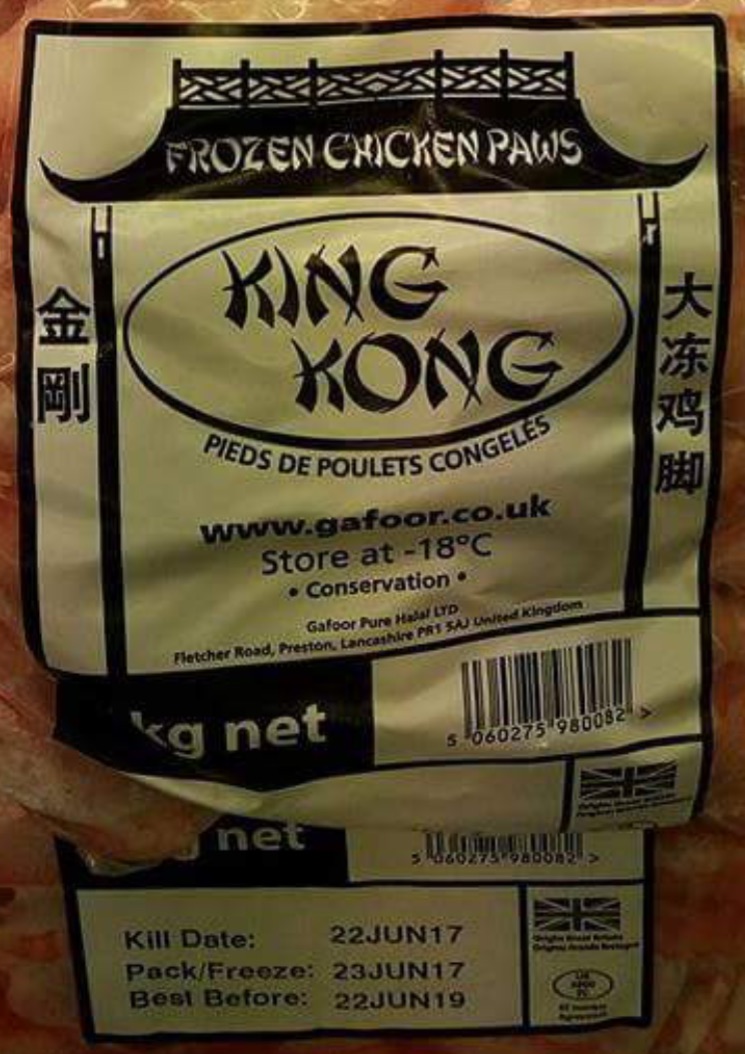Chicken paws and King Kong
« previous post | next post »
A friend of Rebecca Hamilton saw this at a local market in Dundee Scotland:
On the right side of the package it says:
dà dòng jījiǎo 大冻鸡脚
The last two characters mean "chicken feet", but these are more commonly referred to as jīzhuǎ 鸡爪 ("chicken claws").
The first two characters literally mean "big freeze". Several correspondents to whom I showed this were not sure what that signified:
1.
2.
This sounds and looks very odd. I guess it refers to the big size of the frozen chicken feet? Maybe it should be interpreted as dòng dà jījiǎo 冻 大鸡脚 ("frozen big chicken feet").
On the left side of the package it says jīngāng 金刚 (Cant. gam1gong1; Hakka kîm-kông; Minnan kim-kong; Jap. 金剛), which can mean: "diamond; warrior attendant in Buddhism; vajra (Tib. dorje [thunderbolt]); King Kong", etc.
Here's the real origin of the name (for more, see Ben Zimmer's 2006 post, "Nias, Komodo, and 'Kong'"):
Merian C. Cooper was very fond of strong hard sounding words that started with the letter "K". Some of his favorite words were Komodo, Kodiak and Kodak. When Cooper was envisioning his giant terror gorilla idea, he wanted to capture a real gorilla from the Congo and have it fight a real Komodo dragon on Komodo Island. (This scenario would eventually evolve into Kong's battle with the tyrannosaur on Skull Island when the film was produced a few years later at RKO.) Cooper's friend Douglas Burden's trip to the island of Komodo and his encounter with the Komodo dragons there was a big influence on the Kong story. Cooper was fascinated by Burden's adventures as chronicled in his book Dragon Lizards of Komodo where he referred to the animal as the "King of Komodo". It was this phrase along with Komodo and C(K)ongo (and his overall love for hard sounding K words) that gave him the idea to name the giant ape Kong. He loved the name as it had a "mystery sound" to it.
When Cooper got to RKO and wrote the first draft of the story, it was simply referred to as The Beast. RKO executives were unimpressed with the bland title. David O. Selznick suggested Jungle Beast as the film's new title, but Cooper was unimpressed and wanted to name the film after the main character. He stated he liked the "mystery word" aspect of Kong's name and that the film should carry "the name of the leading mysterious, romantic, savage creature of the story" such as with Dracula and Frankenstein. RKO sent a memo to Cooper suggesting the titles Kong: King of Beasts, Kong: The Jungle King, and Kong: The Jungle Beast, which combined his and Selznick's proposed titles. As time went on, Cooper would eventually name the story simply Kong while Ruth Rose was writing the final version of the screenplay. Because David O. Selznick thought that audiences would think that the film, with the one word title of Kong, would be mistaken as a docudrama like Grass and Chang, which were one-word titled films that Cooper had earlier produced, he added the "King" to Kong's name to differentiate.
Kong-size chicken feet!

Keith said,
September 15, 2017 @ 1:32 am
"Chicken paw" is an odd name, and the flag of the UK on the packet, along with the EC identification mark (the oval symbol below the flag) made me wonder why a British producer would use that "erroneous" term.
The producer's web site also uses that term, though, so maybe it's the correct "term of art" for that bit of the carcass.
http://www.gafoor.co.uk/our-products/
And indeed, it seems to be the case. A chicken foot has part of the lower leg attached, while a chicken paw is only the three "toes" (for want of a better word).
https://cooking.stackexchange.com/questions/68192/what-are-chicken-paws
Graeme said,
September 15, 2017 @ 5:24 am
'Kill Date'? Brutal but honest I guess. Is that a standard Scottish, British or EU labelling term?
Dan Lufkin said,
September 15, 2017 @ 10:12 am
Kong is the Danish word for "king" so (I'm told) the film was called Kong King there.
GALESL said,
September 15, 2017 @ 12:00 pm
Is "big freeze chicken feet" perhaps an instance of imposing English adjective order, with size coming before condition? https://en.wikipedia.org/wiki/Adjective#Order
And personally I'm a fan of referring to them as "phoenix claws" 鳯爪 fèng zhuǎ. That way I feel like I'm Sinbad in some (other) stop-motion monster movie, feasting on the very beast that tried to kill me.
Jerry Friedman said,
September 15, 2017 @ 2:05 pm
Keith: "Chicken feet" are in fact feet. What you called "part of the lower leg" corresponds to our foot, and the joint it ends at corresponds to our heel. Birds walk on their toes. Here's a bird resting on its whole feet, from toes to heels.
"Toes" is a good word for what these "chicken paws" consist of. But I'd never heard of chicken paws before.
maidhc said,
September 15, 2017 @ 4:42 pm
We went to a Chinese restaurant recently where some dishes seemed to contain "chicken bladder". This sounds a bit odd. Here is the menu:
https://www.zomato.com/cupertino-ca/mama-chens-cupertino/menu#tabtop
For example, item E25.
All I could find online is that there is a Chinese dish of chicken cooked in a pig's bladder. Perhaps that is what is meant.
I like the sound of "portage soup". The perfect meal for a canoe trip.
Kasey Chang said,
September 15, 2017 @ 11:21 pm
I wonder if it's really noodles with Chicken testicles.
Rodger C said,
September 16, 2017 @ 10:46 am
Getting back to Kong, I wonder if the name wasn't inspired by the West African region of that name. In the early 19th century it was applied to a mostly mythical mountain range, the Mountains of Kong, separating the Sahel from the Gulf of Guinea, and connecting up with the Mountains of the Moon.